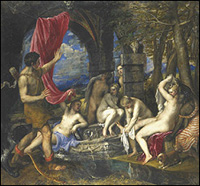 Q&A: Titian paintings
Q&A: Titian paintings London's National Gallery is appealling with its counterpart in Edinburgh
The National Gallery of Scotland and the National Gallery in London are hoping to raise £100m to buy a pair of paintings by Italian Renaissance artist Titian.
The Duke of Sutherland is offering the works to the galleries for £50m each.
The figure represents one third of their estimated open market value, but why is it so important to save the works for the nation, and how difficult will it be to raise the cash?
WHY ARE THE PAINTINGS SO IMPORTANT?
In an interview in 2001, Lucian Freud described the paintings - which can be seen in Edinburgh's National Gallery of Scotland (NGS) - as "simply the most beautiful pictures in the world".
Diana and Actaeon is being offered for sale initially
NGS director general John Leighton said losing Diana and Actaeon would be like France having to give up the Mona Lisa.
"I think it would be hard to exaggerate the misfortune it would be. In our terms it would be like the Mona Lisa being taking out of the Louvre, or the Uffizi gallery in Florence losing its Botticellis," he told the BBC.
Based on Ovid's Metamorphoses, the paintings are part of a group of six that Titian produced for Philip II of Spain between 1556 and 1559.
Revered for their dramatic energy and Titian's striking palette, they are considered a pinnacle in Italian Renaissance art.
HOW MUCH ARE THE PAINTINGS WORTH?
Diana and Actaeon is worth an estimated £150m on the open market, but is being offered for sale jointly to the two galleries for just £50m, if the money is raised by the end of the year.
If the funds can be found, the two galleries will also be given the option to buy the second picture, Diana and Callisto, in four years time for a similar amount.
Once the paintings are secured, the remainder of the Bridgewater Collection - of which the Titians are part - will remain on long-term loan at the National Gallery of Scotland, where they have been on display since 1945.
WHAT IS THE BRIDGEWATER COLLECTION?
The Bridgewater Collection is the most important private collection of Old Master paintings on loan to an institution in the UK - and is among the most important art collections anywhere in the world.
The collection of Old Masters includes four Titians - including Diana and Actaeon and Diana and Callisto - three Raphaels, one Rembrandt and eight Poussins.
It was formed by Francis Egerton, the third and last Duke of Bridgewater, and most of the paintings were acquired following the dispersal of the Orleans Collection after the French Revolution in 1792. The Titians were purchased in 1798.
Visitors were able to see them in a London townhouse on certain days from as early as 1806 - placing them among the first privately owned Old Master paintings to be made accessible to the public in Britain.
The collection has been passed down by descent, and the late 6th Duke of Sutherland loaned the most famous works to the NGS in 1945.
The pictures have been on public view in the gallery ever since.
WHO IS THE DUKE OF SUTHERLAND AND WHY IS HE SELLING THEM?
Francis Ronald Egerton is the 7th and current Duke of Sutherland.
According to the National Galleries, the Bridgewater Collection has grown in value to the point where the Duke decided it would be prudent to review the collection in relation to the family's overall assets.
The Duke's non-art assets were valued by The Sunday Times Rich List at £30m. The two Titians are thought to be worth £300m on the open market, while the rest of the Bridgewater Collection is reportedly worth £1bn.
The Duke's spokesman, Terence Fane-Saunders, said he was "very keen" to see the collection kept together and on public view in the UK.
HOW ARE THEY GOING TO RAISE THE CASH?
The National Galleries have jointly launched a public appeal to raise the £50m needed to secure Diana and Actaeon.
It is likely they will approach the Heritage Lottery Fund, the Art Fund, and the National Heritage Memorial Fund - which finances emergency acquisitions of items of importance to Britain, from artworks to trains.
The galleries also have their own modest resources, and will attract private donations.
In the extremely likely event of a shortfall, the galleries will then approach the UK government's Department for Culture, Media and Sport (DCMS) to seek a contribution from the Treasury, along with Scottish Government ministers.
CAN THEY DO IT?
John Leighton has admitted it will be a "formidable" challenge to raise the cash by the end of the year.
The DCMS has not yet been approached for help, but a spokesman said the groundwork was being prepared in readiness.
But he added he was "not optimistic" that the Treasury would be willing to stump up a large amount of cash if needed.
HAS ANYTHING LIKE THIS HAPPENED BEFORE?
In 2004, the National Gallery secured Raphael's The Madonna of the Pinks for £22m after the Duke of Northumberland decided to sell it.
It had been on loan to the gallery since 1992, but the Duke wanted to sell the artwork to the J Paul Getty Museum, in California, for a reported £29m.
The gallery had around 18 months to raise the funds after the government put a temporary export bar on the painting in January 2003 to "provide a last chance" to raise the cash needed to keep it in the country.
The money was eventually collected by the Heritage Lottery fund and contributions from members of the public.
If the National Galleries fail to secure funding for the Titian by New Year's Eve, and if the Duke was to receive an offer for the painting from abroad, it is likely the DCMS would be approached about the possibility of imposing a similar export ban.
 Q&A: Titian paintings
Q&A: Titian paintings